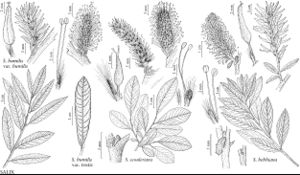Difference between revisions of "Salix humilis var. tristis"
Proc. Ohio Acad. Sci. 4: 301. 1905.
FNA>Volume Importer |
FNA>Volume Importer |
||
| Line 31: | Line 31: | ||
|distribution=Ark.;Conn.;Del.;D.C.;Ga.;Ill.;Ind.;Kans.;Ky.;La.;Maine;Md.;Mass.;Mich.;Minn.;Miss.;Mo.;N.H.;N.J.;N.Y.;N.C.;N.Dak.;Ohio;Okla.;Pa.;R.I.;S.C.;Tenn.;Va.;W.Va.;Wis. | |distribution=Ark.;Conn.;Del.;D.C.;Ga.;Ill.;Ind.;Kans.;Ky.;La.;Maine;Md.;Mass.;Mich.;Minn.;Miss.;Mo.;N.H.;N.J.;N.Y.;N.C.;N.Dak.;Ohio;Okla.;Pa.;R.I.;S.C.;Tenn.;Va.;W.Va.;Wis. | ||
|discussion=<p>Hybrids:</p><!-- | |discussion=<p>Hybrids:</p><!-- | ||
| − | --><p>Although variety tristis is reported to hybridize with Salix eriocephala, S. humilis var. humilis, and S. petiolaris (G. W. Argus 1986), hybrids have not been confirmed.</p> | + | --><p>Although variety tristis is reported to hybridize with <i>Salix eriocephala</i>, <i>S. humilis </i>var.<i> humilis</i>, and <i>S. petiolaris</i> (G. W. Argus 1986), hybrids have not been confirmed.</p> |
|tables= | |tables= | ||
|references= | |references= | ||
| Line 55: | Line 55: | ||
|publication year=1905 | |publication year=1905 | ||
|special status= | |special status= | ||
| − | |source xml=https://jpend@bitbucket.org/aafc-mbb/fna-data-curation.git/src/ | + | |source xml=https://jpend@bitbucket.org/aafc-mbb/fna-data-curation.git/src/8f726806613d60c220dc4493de13607dd3150896/coarse_grained_fna_xml/V7/V7_138.xml |
|genus=Salix | |genus=Salix | ||
|subgenus=Salix subg. Vetrix | |subgenus=Salix subg. Vetrix | ||
Revision as of 18:55, 18 September 2019
Low to mid shrubs, 0.3–1 m. Stems decumbent; branches tomentose, peeled wood smooth or striate, striae sparse, to 2 mm; branchlets yellow-brown. Leaves: stipules absent or rudimentary on late ones; petiole 0.5–3(–6) mm, velvety or villous adaxially; largest medial blade narrowly oblong, narrowly elliptic, oblanceolate, or obovate, (13–)20–50(–70) × 3–13 mm, 2.3–9 times as long as wide, margins strongly revolute, abaxial surface hairs gray throughout, adaxial slightly glossy, moderately densely tomentose; proximal blade margins entire. Catkins: staminate 6.5–13.5 × 5–10 mm, flowering branchlet 0–1 mm; pistillate 11–17.5 × 5.5–12 mm, flowering branchlet 0–1.5 mm; floral bract 0.8–1.4 mm. Staminate flowers: filaments glabrous or hairy basally. Pistillate flowers: ovary pyriform; ovules 6 per ovary; stigmas 0.2–0.24–0.32 mm. Capsules 5–9 mm.
Phenology: Flowering early Mar-late May.
Habitat: Moist limestone and serpentine barrens, open heath balds, open pine woods, moist prairies, swampy areas in open deciduous woods, stream banks
Elevation: 60-1600 m
Distribution

Ark., Conn., Del., D.C., Ga., Ill., Ind., Kans., Ky., La., Maine, Md., Mass., Mich., Minn., Miss., Mo., N.H., N.J., N.Y., N.C., N.Dak., Ohio, Okla., Pa., R.I., S.C., Tenn., Va., W.Va., Wis.
Discussion
Hybrids:
Although variety tristis is reported to hybridize with Salix eriocephala, S. humilis var. humilis, and S. petiolaris (G. W. Argus 1986), hybrids have not been confirmed.
Selected References
None.
